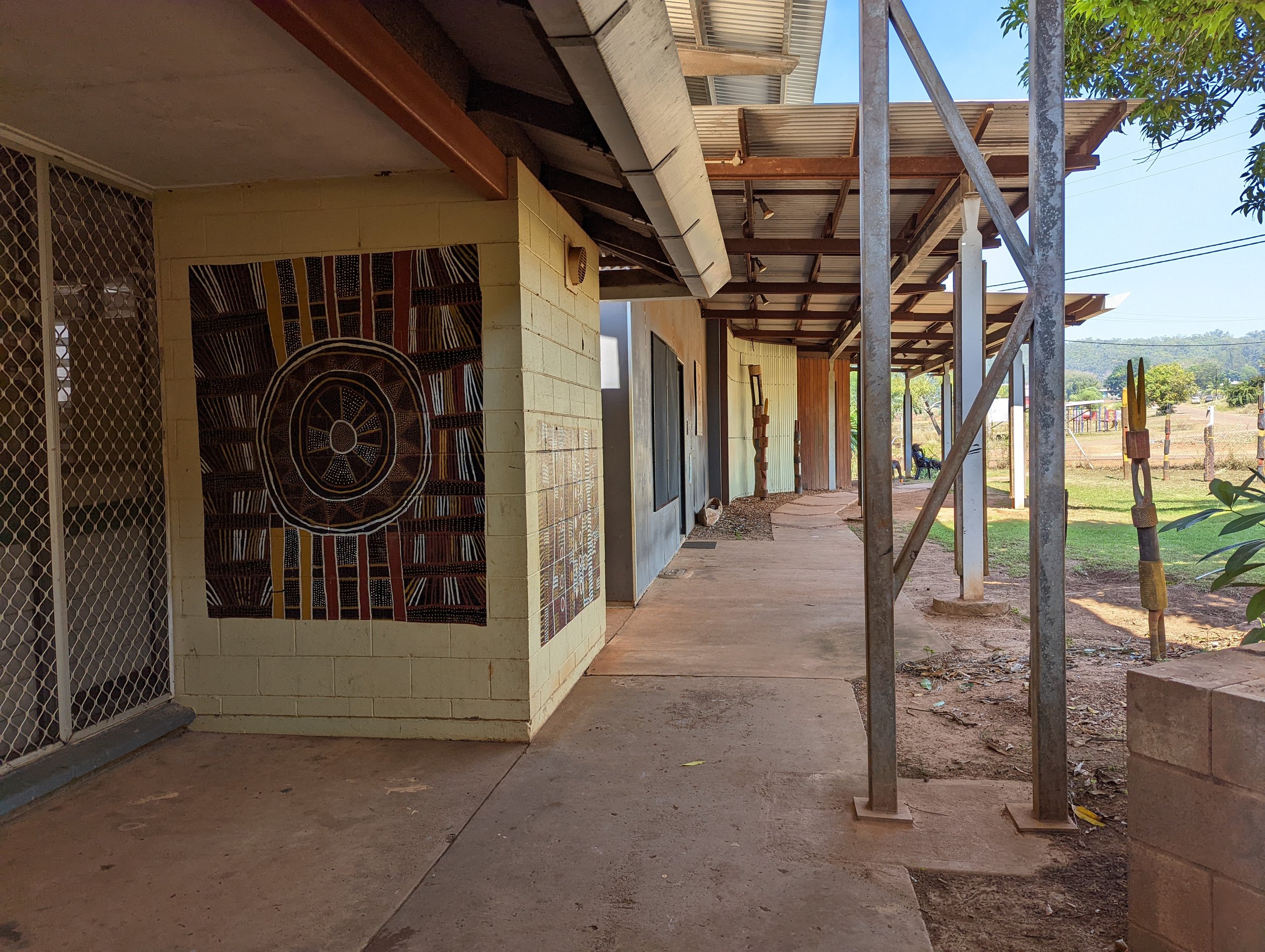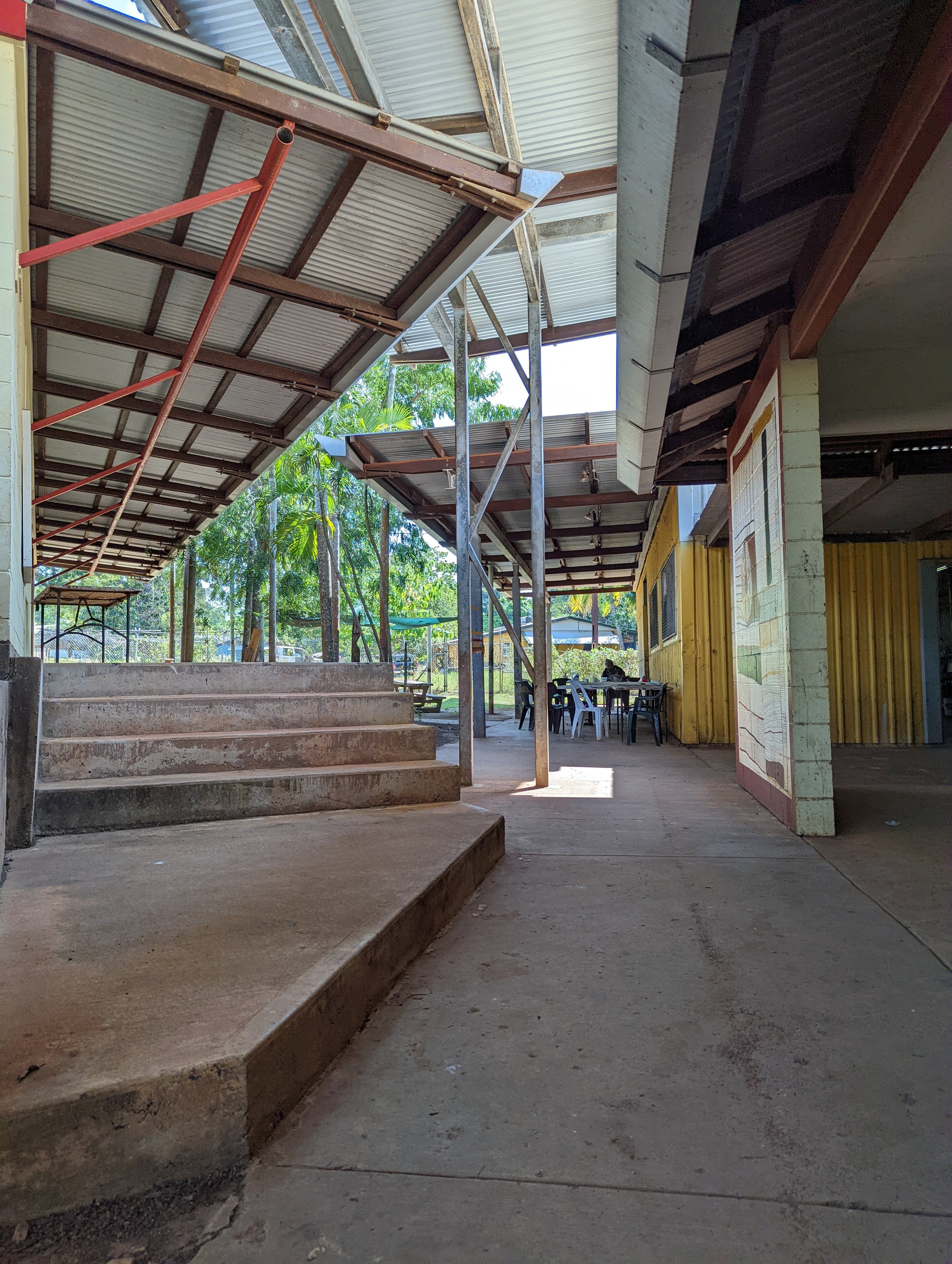
Case Study:
Jilamara Arts & Crafts
Established in 1989, Jilamara Arts and Crafts Association is owned and governed by artists from the community of Milikapiti on the Tiwi Islands. Comprised of two main islands Bathurst and Melville, the Tiwis are north of Darwin and have been home to Tiwi people since parlingarri (creation time). The Milikapiti community is on Wulirankuwu Country on the north coast of Melville Island overlooking the Arafura Sea.
The term Jilamara describes “design” based on ceremonial ochre markings on the body. Reimagining these styles at the art centre has fostered a dynamic creative field for maintaining Tiwi knowledge, as well as sharing and celebrating contemporary living culture. These performative foundations have directed the organisation’s course for decades, from its origins in translating jilamara design to screen-printed garments as an adult education centre in the 1980s to producing major exhibition outcomes as an indigenous governed art centre in more recent decades*.
*(text from Jilamara’s website)

Fly Tiwi occupy a small building on the edge of Darwin Airport running charter flights twice a day to the Tiwi Islands, 80 kilometres north. I climbed into a 18 seat propellor plane, and it was not long before we were flying low over Melville Island heading for Milikapiti, a town of c.410 people. Rivers and waterways glistened in the sun as they snaked through wild forests that were distinguished from the extensive patches of plantations – an important Tiwi industry.
I spent two days from the 13-15 June 2022 at Jilamara. On arrival, I was given a tour first by the art centre manager and then by artists who showed me their beautiful works hanging in the gallery and albums of them and their families in the early days of the art centre. The Tiwi are renowned for their friendliness and experienced it firsthand.
Throughout my visit to Jilamara, I found atmosphere was relaxed and welcoming with community, visitors and the local cow Lady Gaga, coming and going throughout the day. I wandered across the site, appreciating all of the different spaces that were created around the buildings and under the connection canopies. I sat in a breezeway with the women while one painted and another ground white ochre gathered on a recent trip. Top End Aboriginal Bush Broadcasting Association playing rock and pop that mixed with animated chatter.

Large, coloured murals decorate the walls of the museum and the art centre that date from the late 1990s.
Architecture
Jilamara Arts and Crafts is a collection of buildings and surrounding landscape that has been developed in stages over the past 35 years. In 1989 the Milikapiti Cultural Complex was built which included the Muluwurri Museum and the Adult Education Centre, occupying basic concrete block buildings, with a screen print workshop in a shed behind.
In 2004 Jilamara received funding for a feasibility study conducted by Troppo Architects, with plans developed and executed over subsequent years. The first stage was a new gallery that opened in 2009 and the final renovations and new buildings were opened in 2012 by Pedro Wonaeamirri, President of Jilamara Arts and Crafts. These include the Kutuwulumi Gallery, named after the late Kitty Kantilla, with artworks for sale, and the Murrunungumirri Carvers Shed named after the late Paddy Freddy Puruntatameri. The adult education centre building was renovated to house the Muluwurri Museum Collection. The entrance has been moved from the street-side, and now presents a quiet façade to the community, with translucent corrugated polyurethane sheets and glass louvres at either end. This provides a very pleasant backdrop to the central display space. Further rooms provide more enclosed spaces for the presentation of artefacts, photographs and memorabilia and there is a secure air-conditioned room to store archives and repatriated objects.
Entering Jilamara Arts and Crafts from the front gate
The women’s shed, named after acclaimed artist Nancy Henry Ripijingimpi has a textile screen printing studio, with a sewing room and amenities at one end that define an entrance passage. Two large roller doors on either side open to allow people and air to pass through. Artwork packing, kitchen and amenities are housed in one of the original concrete block buildings.
The spaces between the buildings are carefully designed with connecting canopies over the paths and verandahs that offer places for artists to work. There are solar panels on the roof of the gallery. The site includes space for communal gatherings for special events, and has fire pits to cook food.
1. Main gate entrance
2. Managers office and artist space
3. Mezzanine with storage above
4. Kutuwulumi Gallery
5. Artwork racks
6. Packing and art preparation
7. Kitchen
8. Store
9. Nancy Henry Ripijingimpi, women’s shed (screen-printing)
10. Sewing Room
11. Caretakers room/ office
12. Muluwurri Museum
13. Archive and Keeping Place
14. AV screening room
15. Murrunungumirri Carvers Shed
16. Print making space
17. Staff and loading entrance
Elegant canopies connect the buildings, old and new, with beautifully designed columns that in my mind evoked the Tutini poles that sat nearby. The large gutters and roof overlaps are necessary for the tropical downpours in the wet season.
Muluwurri Museum (above and left) has been clad in polycarbonate sheeting that allows diffuse light into the gallery with a slot of glass louvres providing views to the community. The Museum has an informative display, presented in a simple fit out, that includes an introduction to Tiwi culture and life, the Milikapiti community and Jilamara Arts and Crafts.
To the left of the window is a painting that was originally on the facade of the building before it was enclosed. Next to it, one of five murals on Masonite that previously decorated the Milikapiti Store.
Kutuwulumi Gallery, named after the late Kitty Kantilla
Nancy Henry Ripijingimpi, women’s shed, with a long screen-printing table running it’s length with storage and sinks to one end. Roller doors open to connect the screen printing shed and the adjoining verandah where tables are set up for artists to work.
The Murrunungumirri Carvers Shed, named after the late Paddy Freddy Puruntatameri, was added onto an existing building.









